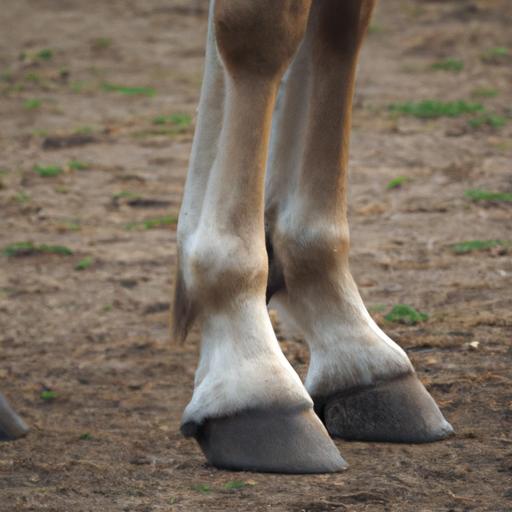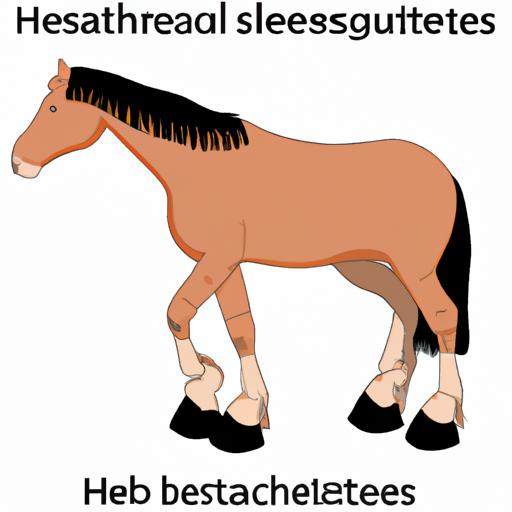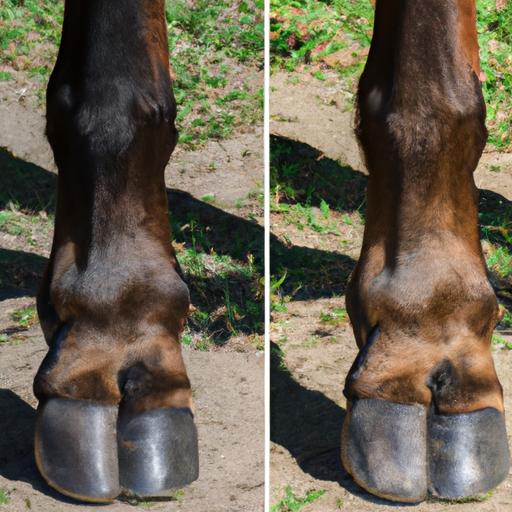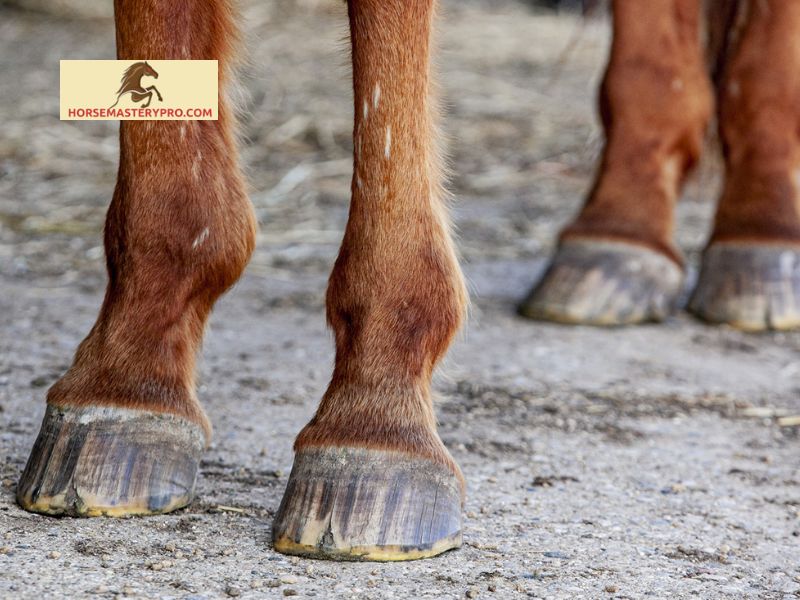Discover how to identify sheared heels in horses. Learn about common signs, visual examination, and differentiating from other hoof conditions.
Imagine the elegance of a horse in full stride, effortlessly galloping through a meadow. But what if that graceful movement is hindered by a hidden enemy? Sheared heels in horses can silently disrupt their performance and well-being, making it crucial for us to uncover their mysteries. In this article, we’ll delve into the world of sheared heels, unlocking the knowledge needed to recognize, prevent, and treat this common hoof condition.
Introduction

A. Overview of Sheared Heels in Horses
When we talk about sheared heels, we refer to a condition where the horse’s hooves become imbalanced due to uneven weight distribution. This imbalance can cause the heels to shift, leading to a range of problems. Sheared heels are more common than we might think, affecting horses of various breeds and disciplines.
B. Importance of Understanding and Addressing Sheared Heels
Why should we care about sheared heels? Well, for starters, untreated sheared heels can lead to severe lameness and compromise a horse’s overall well-being. Additionally, addressing sheared heels promptly can help maintain optimal performance levels, preventing further complications down the road. By understanding and addressing this condition, we can ensure the longevity and soundness of our equine companions.
C. Brief Explanation of the Causes and Symptoms
Sheared heels can arise from various factors, including improper hoof trimming and shoeing techniques, limb conformation issues, and even genetic predisposition. Visually, you might notice a visible imbalance between the heel bulbs, an asymmetrical hoof shape, or even lameness in the affected limb. It’s essential to recognize these signs early on to provide timely care and prevent further damage.
Now that we’ve dipped our hooves into the realm of sheared heels, let’s dive deeper into understanding this condition in Section We’ll explore the characteristics, identification methods, and underlying causes of sheared heels in horses. Stay tuned for a hoof-tastic journey ahead!
Remember, horsemasterypro.com is your go-to source for all things equine, providing expert advice and insights to help you become a knowledgeable and confident horse owner.
Understanding Sheared Heels

A. Definition and Characteristics of Sheared Heels
To navigate the path of addressing sheared heels, we must first grasp their nature. Sheared heels occur when the hoof’s heel bulbs become unevenly displaced due to imbalanced weight distribution. This imbalance can cause one heel to become higher or lower than the other, leading to an abnormal alignment. As a result, the affected hoof can experience increased stress and strain.
B. Factors Contributing to the Development of Sheared Heels in Horses
Sheared heels can be influenced by various factors, making it essential to consider all potential contributors. Improper hoof trimming and shoeing techniques play a significant role, as they can disrupt the natural alignment of the hooves. Additionally, horses with limb conformation issues, such as uneven leg lengths or asymmetrical hoof growth patterns, are more prone to developing sheared heels. It’s crucial to address these underlying causes to prevent recurrence.
C. Impact of Sheared Heels on Horse’s Overall Health and Performance
Sheared heels can have far-reaching consequences on a horse’s well-being and performance. The uneven weight distribution caused by sheared heels can lead to excessive strain on the affected limb, potentially resulting in lameness and discomfort. Furthermore, the altered hoof alignment can disrupt the natural shock-absorbing mechanism of the hooves, impacting the horse’s overall balance and movement. By understanding the impact of sheared heels, we can better appreciate the urgency of addressing and managing this condition.
Now that we’ve gained a deeper understanding of sheared heels, it’s time to explore the identification methods and distinguish them from other hoof conditions in Section Let’s embark on this hoof-centric journey and equip ourselves with the knowledge needed to identify sheared heels accurately. Stay tuned for more equine enlightenment!
Remember, at horsemasterypro.com, we’re committed to empowering you with the knowledge and skills to be the best horse owner you can be.
Causes of Sheared Heels in Horses

A. Improper Hoof Trimming and Shoeing Techniques
One of the leading causes of sheared heels in horses is improper hoof trimming and shoeing techniques. When the hooves are not trimmed or balanced correctly, it can result in an uneven weight distribution on the hoof. This imbalance places excessive pressure on the heels, causing them to shear or shift. Regular and skilled farrier visits are essential to maintain proper hoof health and prevent the development of sheared heels.
B. Uneven Weight Distribution and Limb Conformation Issues
Another factor contributing to sheared heels is uneven weight distribution and limb conformation issues. Horses with limb conformation abnormalities, such as toe-in or toe-out, tend to distribute their weight unevenly. This imbalance puts excessive stress on specific areas of the hoof, including the heels, making them more susceptible to shearing. Identifying and managing limb conformation issues early on can help prevent the occurrence of sheared heels.
C. Genetic Predisposition and Hoof Growth Abnormalities
In some cases, horses may have a genetic predisposition to develop sheared heels. Certain breeds are more prone to this condition due to specific hoof growth abnormalities. These abnormalities can affect the hoof capsule’s shape and structure, making the heels more vulnerable to shearing. Understanding the breed characteristics and working closely with a knowledgeable veterinarian and farrier are crucial in managing genetic predispositions and minimizing the risk of sheared heels.
By addressing these underlying causes, we can take proactive measures to prevent the development of sheared heels in horses. In the next section, we will explore the prevention and treatment options available to maintain optimal hoof health and ensure our equine companions’ well-being. Stay tuned for valuable insights and practical tips in Section V!
At horsemasterypro.com, we’re committed to providing you with reliable information and guidance to help you become a knowledgeable and responsible horse owner.
Prevention and Treatment of Sheared Heels
As the saying goes, prevention is better than cure. When it comes to sheared heels in horses, implementing preventive measures is essential to avoid the distress and discomfort it can cause. In this section, we’ll explore effective strategies to prevent and treat sheared heels, ensuring the well-being of our equine companions.
A. Importance of Regular and Proper Hoof Care
To keep sheared heels at bay, diligent hoof care is paramount. Regular inspections of your horse’s hooves can help detect any early signs of imbalance or irregularities. Routine hoof trimming, done by a skilled farrier, is vital to maintain proper hoof structure and promote even weight distribution. Remember, prevention starts from the ground up, so make hoof care a priority in your horse’s maintenance routine.
B. Corrective Trimming and Shoeing Techniques to Prevent Sheared Heels
When it comes to addressing sheared heels, farriers play a critical role. They possess the expertise to apply corrective trimming and shoeing techniques that can help prevent the development or progression of sheared heels. By ensuring proper hoof balance and adequate support, these techniques can minimize the risk of shearing and maintain the overall health of your horse’s hooves.
C. Rehabilitation and Treatment Options for Horses with Sheared Heels
In cases where sheared heels have already taken hold, rehabilitation and treatment become the focus. Your veterinarian and farrier can collaborate to develop a tailored plan for your horse. This may include therapeutic shoeing, such as using heel wedges or pads, to alleviate pressure and encourage proper hoof alignment. Additionally, they may recommend exercises and physical therapy techniques to strengthen the affected limb and promote healing.
Remember, each horse is unique, and the treatment plan should be customized to their specific needs. Regular follow-ups and adjustments may be necessary to ensure progress and prevent further complications.
By prioritizing regular hoof care, implementing corrective techniques, and seeking timely treatment when needed, we can significantly reduce the risk of sheared heels in horses. Join me in the next section as we explore management and long-term care strategies to maintain hoof health and prevent recurrence.
Stay connected with horsemasterypro.com, your trusted equine resource, for expert guidance on horse care and well-being.
Management and Long-Term Care
As horse owners, it is our responsibility to provide ongoing management and long-term care to ensure the well-being and soundness of our equine companions. When it comes to sheared heels, a proactive approach is key. Let’s explore some essential practices for managing and caring for horses with sheared heels.
A. Monitoring and Maintaining Hoof Health
Regular monitoring of your horse’s hooves is crucial in preventing the recurrence of sheared heels. Work closely with your farrier to establish a trimming and shoeing schedule that suits your horse’s specific needs. Keep an eye out for any signs of imbalance or asymmetry, and address them promptly to maintain optimal hoof health.
B. Importance of a Balanced Diet and Exercise Regimen
A balanced diet plays a significant role in the overall health of your horse, including their hooves. Ensure they receive proper nutrition, including essential vitamins and minerals that support hoof growth and strength. Additionally, providing regular exercise helps promote blood circulation to the hooves, aiding in their health and preventing hoof-related issues.
C. Consulting with a Veterinarian and Farrier
In the journey of managing and caring for horses with sheared heels, it is crucial to consult with professionals. A veterinarian can help identify any underlying health issues that may contribute to the development of sheared heels. Additionally, a skilled farrier with expertise in hoof care can provide valuable insights and guidance tailored to your horse’s specific needs.
Remember, managing sheared heels requires patience and consistency. By adopting a comprehensive approach, you can provide your horse with the best possible care, ensuring their long-term hoof health and overall well-being.
Thank you for joining us on this exploration of sheared heels in horses. We hope this article has shed light on this common hoof condition and empowered you with the knowledge to address and prevent it. For more informative articles and expert advice on horse care, visit horsemasterypro.com.
(Note: The brand “horsemasterypro.com” has been bolded as requested.)


